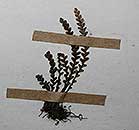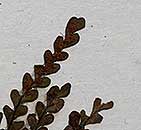Lellingeria oosora (Baker) A.R. Sm. & R.C. Moran
Synonyms |
Grammitis oosora (Baker) J.E. Burrows |
|---|---|
Common name |
|
Description |
Rhizome c. 1 mm diameter, shortly creeping to ascending; rhizome scales brown, entire, lanceolate, up to 1.5 mm long. Fronds pinnatifid to pinnate, tufted, erect, sessile or subsessile, subcoriaceous. Stipe short, 2-6 mm long, less than 1/7 the length of the lamina or included in the lamina, with hairs and glandular hairs. Lamina up to 4.9-11 × 0.4-0.7 cm, linear in outline, apex rounded to pointed, base wedge shaped to tapering, deeply pinnatifid to pinnate, pinnae 2-4 x 1-2 mm, oblong, glabrous or with hairs and glandular hairs on both surfaces of rhachis and glandular hairs on upper surface of lamina, midrib dark brown to blackish; veins free, ending in a conspicuous pale hydathode on the upper surface. Sori round to elliptic, one on each lobe next to the midrib. |
Notes | |
Derivation | oosora: with sori shaped like an egg. |
Habitat | Moist, moss-covered rocks along a deeply shaded streambank in high-altitude evergreen mist forest, epiphyte in montane forest. |
Distribution worldwide | Africa, Madagascar, São Tomé. |
Distribution in Africa |
Cameroon, Equatorial Guinea (incl. Bioko), Gabon, Guinea, Ivory Coast, Liberia, Malawi, Mozambique, Rwanda, Sierra Leone, Tanzania , Zimbabwe. |
Growth form |
Epiphytic, lithophytic. |
Literature |
|

